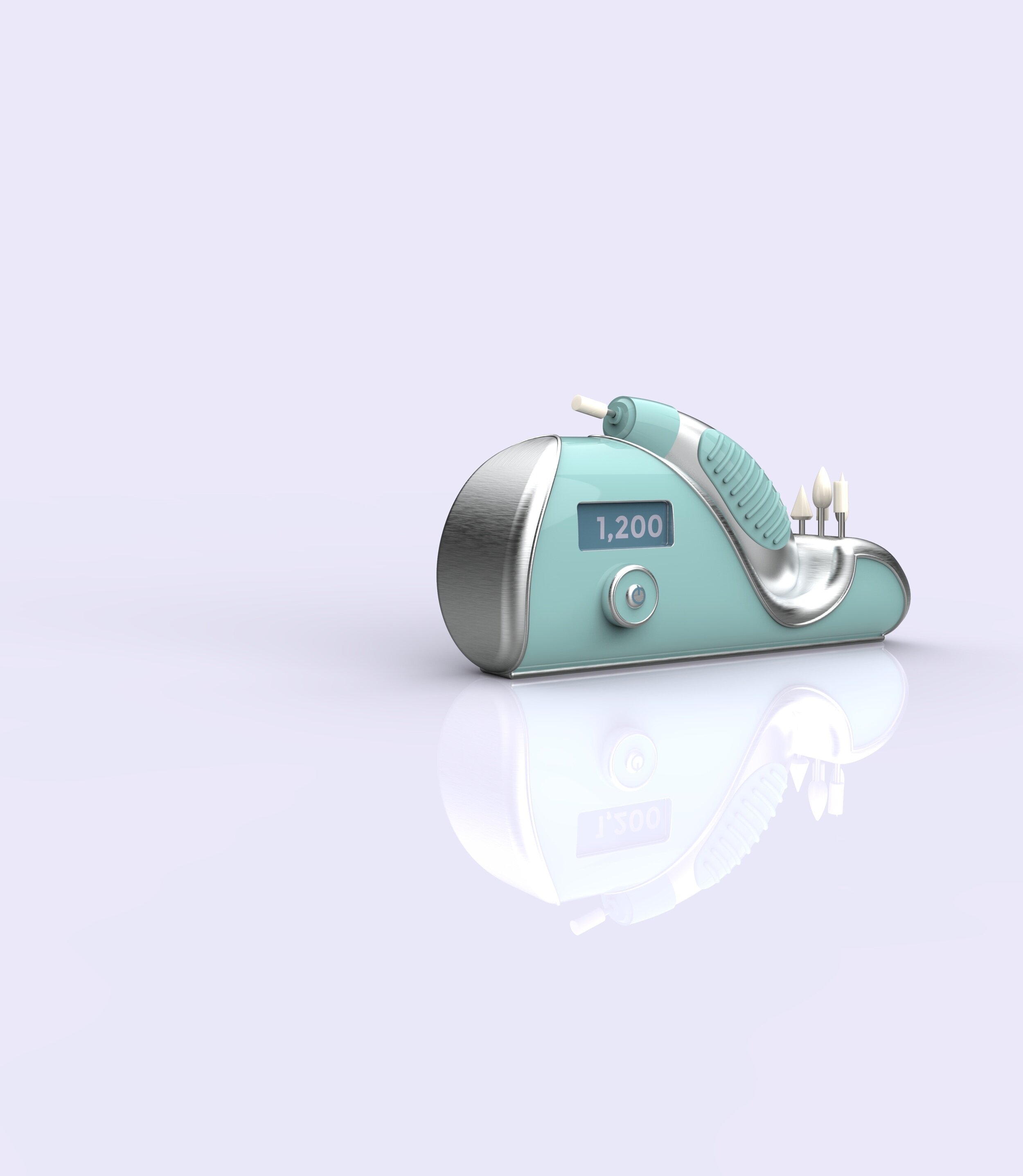
Overview
ROLE
Product Designer
TOOLS
Adobe Creative Suite (Id, Lr)
Fusion 360
KeyShot
TIME FRAME
5 Weeks
Fall 2019
Project Background
How would you improve a hand tool?
This project involved exploring the complexity of empathy around users and ergonomics. We chose a hand tool grip to re-design through rapid prototyping, testing and refinement. Utilizing the user insights gained through interviewing a professional, we created a final high-fidelity looks-like model of the re-designed tool.
Background on e-files
An electric file allows nail technicians to file or finish areas of the nail that are hard to reach. They can enhance the nail tech’s filing methods by allowing her to shape nails faster, do more proficient back-fills, and refine the cuticle area with precision. They are commonly used to refine artificial acrylic, gel toenail services, and callus refinement during pedicures.
User Experience
Identifying key insights
I chose to interview a Nail Technician to gain insights regarding the electric file. As she did my nails, I noted down the steps of the process by creating an Experience Map, and the highs and lows of the experience through a Journey Map.
Insights
Identifying design needs
After interviewing my professional, it became clear that there were three key insights I wanted to explore. The re-design of my tool would be to resolve these insights and design a better experience for both the technician and the customer.
UNCOMFORTABLE GRIP
The grip on the tool is not defined. This prevents better control, and the weight distribution causes wrist strain. This could be solved by adding a grip, grooves, and changing the way the fingers grip the tool.
DIRTY AND HOT BIT
Nail particles get stuck in grooves and affect the filing rate of the machine. Since they’re made of metal, they also heat up due to the friction. This could be solved by decreasing the depth of grooves and changing the material of the bit.
INTIMIDATING APPEARANCE
The e-file’s appearance is too similar to a Dremel. This ends up making the customer nervous as the loud sound of the file, combined with its utilitarian appearance, could make the customer nervous.
Design Requirements
Changing it from a precision tool
The vibration of the tool causes strain on the thumb and forefinger when the tool is held in a pencil grip. Opening up the grip, and re-distributing the force to the rest of the palm, could solve this issue.
Making it cordless, but still powerful
Having a cord disrupts the filing motion and gets in the way when filing. Making it cordless would resolve this issue, but I would need to find a way to ensure that the controls are not on the file body itself or the buttons would interfere with the use.
Keeping it friendly
Its appearance is too nerve-inducing for a customer who is expecting a relaxing manicure at a nail salon. Making the tool look more friendly and welcoming, while not compromising on its function, could resolve this issue.
Concept Ideation
Opening up the hand grip
I first conducted a market analysis to compare existing e-files on the market. These files ranged from being rather harmful to the user to being ergonomic, but weak. I sketched some thumbnails of varying e-file forms, before committing to three distinct grip styles to use as my final three concept choices.
Prototyping
Rapid, Rough Prototyping
After creating rough prototypes of my three final concepts, I brought them back to the professional I initially interviewed to gain more user feedback. My professional went through the nail filing motions and compared the grip and ease of use for each of the three concepts.
Concept 1: The Chili Pepper
While the user liked the length, the tool put the fingers too close to the rotating bit. The position of the grips would effect how bulky it would look. This concept also didn’t resolve the problem of holding a pencil grip for extended periods of time with the vibration. Since it forces your grip inwards, the angles to reach the rest of your fingers is affected, which causes your other hand to work more and compensate by rotating the client’s fingers more.
Concept 2: The Eggplant
The length was a tad bit long for small hands. Side grips could encourage stepping away from the pencil grip and relieve most of the tension on the thumb and forefinger. Some angles are hard to reach with the tool since the length extends too far. She preferred this grip the best, provided I adjusted it a bit more.
Concept 3: The Mango
The size was far too large for small hands. It would not support the inclusion of grooves and pops out of hands very easily. She preferred holding it in a pencil grip rather than an open one, and she liked how changing grips would reduce strain on wrist. However, she was not able to control the bit position for this concept.
Final Model
Improving it technologically
I chose to develop the Eggplant prototype for my final model. After testing various dimensions with my user testing through prototyping with pink foam, I settled on these final dimensions. But then one of my users had an epiphany, what if we utilized a Bluetooth controlled motor? This would allow the tool to be cordless, while delegating the controls to the control box so it wouldn’t interfere with the grip. I used Autodesk Fusion 360 to CAD my form + control box, and KeyShot was used later to render.













![hand toolb 2].png](https://images.squarespace-cdn.com/content/v1/5f8a6bac27d26a70a29b8597/1603166994433-A8CW1DMLIYU31FHXF14W/hand+toolb+2%5D.png)
